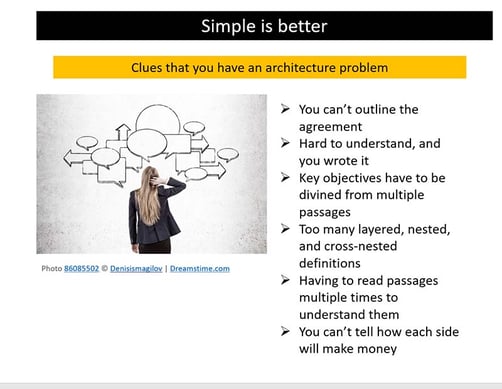Amgen, Inc. v. Amneal Pharmaceuticals LLC, Civ. No. 16-853-MSG (D. Del., September 19, 2019)
Amgen shows solid, creative thinking of the good kind by both parties in a very complex dispute involving a settlement agreement with patent license aspects. The final result of this dispute is still open, as the appeal to the Federal Circuit is pending.
There are multiple ways to structure any technology agreement, although the choices seem to increase geometrically in increasingly complex relationships. Most of the time, if the choice is between a simple agreement architecture that covers all the bases and one that is more complex, simple is better. Once the architecture is pinned down, a simple agreement is easier to draft, easier to negotiate, easier to live under, less likely to cause disputes, and generally easier to enforce.
 But getting to a simple architecture that does the job is hard in complex deals. Often, initial thinking provides a structure with too much complexity, and then it takes hard work to fix that complexity with something that is still complete but simpler. Unfortunately, sometimes a draftsperson moves forward with drafting without exploring if the agreement architecture can be improved. The result is a too complex final agreement that is hard for the parties and judges to understand. Joint development agreements are particularly notorious for complex architecture issues, as some of these have more unnecessary layers than the most layered onion.
But getting to a simple architecture that does the job is hard in complex deals. Often, initial thinking provides a structure with too much complexity, and then it takes hard work to fix that complexity with something that is still complete but simpler. Unfortunately, sometimes a draftsperson moves forward with drafting without exploring if the agreement architecture can be improved. The result is a too complex final agreement that is hard for the parties and judges to understand. Joint development agreements are particularly notorious for complex architecture issues, as some of these have more unnecessary layers than the most layered onion.
Complex agreements can catalyze disputes. Perhaps the parties might never really had a meeting of the minds but could not tell that, or down the road, after memories and personnel have changed, the meaning of the agreement is hard to divine. Complex agreements also give one party an ability down the road to change the meaning of the original agreement because the complexity makes the agreement provisions hard to pin down one way or the other. Complex architecture might only be an advantage to a party who needs to creatively manipulate the agreement meaning to secure some advantage.
Amgen is a case involving an agreement whose architecture was much more complex than needed. One way to tell this agreement suffered from too much complexity is that one of the most important aspects of the agreement could not be understood from a single section. Its meaning had to be divined from how many different sections of the agreement interacted with each other. The key issue being litigated was an important aspect known to the parties at the time the agreement was negotiated and signed, so this is not a circumstance under which a later, unforeseeable circumstance surprised the parties. The parties could have done better with a simpler agreement structure, although the complexity of the agreement did give the conditional licensee an opportunity to attempt to seize its coveted license through creative interpretation.
This dispute centers on a settlement agreement made in a Hatch-Waxman patent infringement case. Amgen originally brought claims against several defendants in the Sun pharmaceutical family (Sun) in response to an ANDA filing by Sun. The parties settled that dispute under terms where Sun would stay out of the market. However, the agreement provided that Sun would have a patent license if a third party enters the market and Amgen did nothing about it. This conditional license is one of the main aspects of the settlement agreement and a main focus of the case. Unfortunately, the agreement obscured the conditional license with too much complexity. This made it hard prior to the litigation for Amgen to convince Sun that the conditions for the license had not yet occurred. The complexity also gave Sun a chance to weave together several agreement provisions in an attempt to show why its license materialized.
After the settlement agreement had been placed, third parties TEVA/Watson launched a competitive product. In line with expectations under the settlement agreement with Sun, Amgen stopped TEVA/Watson quite quickly. However, TEVA/Watson were able to distribute substantial amounts of product to distributors before TEVA/Watson exited the market. Amgen never pursued any of the TEVA/Watson distributors after shutting down TEVA/Watson.
As a consequence of the product being in the hands of TEVA/Watson distributors, Sun believed it now had a patent license and could enter the market. Sun believed the distributors were third parties in the market with Amgen doing nothing about it. Amgen disagreed, not wanting Sun to have the license. This litigation resulted to determine if Sun’s license existed or not.
Does Sun get a license? The district court determined that Sun does not get any license under “the plain meaning of the terms as used in the Agreement.” But, understanding the agreement was not as simple as portrayed in the Court’s conclusion. It is a bit ironic that the court relied on the “plain meaning” rubric in its ruling, because the agreement construction could not be resolved by looking at only one passage of the agreement. The court had to evaluate a complex web of many agreement sections from the settlement agreement in order to figure out whether Sun had a license. Both parties and the court had to dig deep to interpret the agreements. Both parties were creative, but in the good way unlike the licensor in Alexsam.
This case is a good example of where simpler agreement architecture should have been available and would have been better. This case is a good example to show how too much agreement complexity catalyzes downstream disputes. The lesson is that a practitioner should not settle on a given agreement architecture too soon in the drafting process. Invest the time to determine if the initial construction can be simplified or otherwise made better. Clues that you have a problem include one or more of the following: you are unable to outline your structure easily;, the agreement is hard to understand even though you wrote it; some definitions seem to be doing very little for the agreement much like unnecessary middle managers in an overstaffed corporation; it is hard to follow key provisions without flipping back and forth to several other provisions; the answers to key objectives have to be divined from multiple passages; etc.

